|
 Secure Site
Secure Site
|
 |
Archive for the 'Meditation Tools' Category
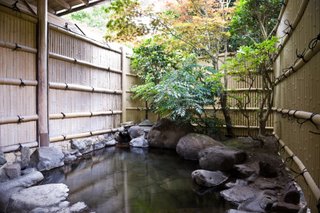 sacred soaking Water, a powerful and restorative element in exquisite rituals throughout the ages, finds itself front and center in most spiritual rites of passage. Many cultures consider water essential for both physical and spiritual cleansing, and millions continue to embark upon quests to holy rivers and healing springs, drawn to water equally for its soothing properties as well as its promise of purification.
Perhaps this draw to water feels so instinctual because our brains, blood, and even our muscles are composed mainly of water. When we submerge ourselves, we return, in essence, to a deep, primordial connection with the world around us. Through the simple act of bathing, we can celebrate this ancient relationship between water and life. With minimal effort, a daily bath becomes a meditative and mystical experience, helping us to connect with our own inner wisdom.
“Mankind has used water to restore the physical, mental, and emotional body since ancient times,” says Barbara Close, founder of Naturopathica Holistic Health and author of Pure Skin: Organic Beauty Basics (Chronicle Books, 2005). “From the beginning, the use of water as a conduit or healing agent has existed for both its physical and emotional healing properties.”
Long before holy wells began to draw pilgrims or the custom of “taking the waters” became popular at lavish bathing halls in Europe, ancient cultures in Asia, Indonesia, and Mesoamerica had their own elaborate bathing rituals, which often involved the use of steam and ceremonial sound. Both the Aztec Temazcal and Mayan Zumbul-che wove in musical elements to signify the start of the cleansing ritual. In parts of today’s world, including Indonesia, Southeast Asia, and island nations of the Pacific, cultures still associate wells, springs, and rivers with the Goddess, the feminine principle, and birth. Women add flower petals to ritual water as an extra flourish, imbuing their bath with the powerful spiritual energy associated with native plants. In the Javanese bath ritual that prepares brides for their wedding night, attendants first scrub and exfoliate the skin with turmeric and then rub it with yogurt to soften it. A luxurious bath with flowers and petals follows, and only then is the bride deemed purity incarnate.
 water “Each and every one of us, and every fragment of life on our planet, has an inner and outer relationship with water,” says Nadine Epstein, author (with Rosita Arvigo) of Spiritual Bathing: Healing Rituals and Traditions From Around the World (Celestial Arts, 2003). “The first living cells were formed in the salt bath of the sea, and I love imagining the blood that flows within us as a kind of internal sea. We are beings of water on a planet that is distinguished by its possession of water, the rushing waters that the early Jews called ‘living waters’ or mayyim hayyim.”
Ritual and renewal
You can connect with the healing energy of water by preparing your own spiritual bath at home. First order of business: Decide what you want to manifest in your life. The prospects run the gamut from the desire to release personal sadness or frustration to the hope of reducing global suffering. Next, establish the mood. The usual suspects, candles and incense, have traditionally been part of many prayer settings, but let your imagination run wild. Create an even richer ambiance by including specific music, scents, symbols, and images that resonate with your concept of the divine.
“Personally, I love singing and chanting on the surface of the water, watching the ripples of my breath, and soaking up the sounds in the air,” says Epstein. “I’ve always been fascinated by sound waves and how they travel through solids, gases, and liquids. As a little girl, I remember my father, a physicist, mapping the trajectory of sound waves through crystals. The symmetries of these waves were and are a beautiful thing to behold. It all boils down to connecting with what the Maya call ch’ulel, the Chinese call chi, the Hindus call prana. Nearly every culture has a name for the subtle energies or vibrations that exist within us and beyond.”
Ultimately, only the reverence with which we enter the water matters. If we are receptive enough, our immersions can gradually wring a sea change upon our spirit, teaching us that we can learn as much from floating as we can from standing on firm ground.
Although meditation can be done in almost any context, practitioners usually employ a quiet, tranquil space, a meditation cushion or bench, and some kind of timing device to time the meditation session. Ideally, the more these accoutrements can be integrated the better. Thus, it is conducive to a satisfying meditation practice to have a timer or clock that is tranquil and beautiful. Using a kitchen timer or beeper watch is less than ideal. And it was with these considerations in mind that we designed our digital Zen Alarm Clock and practice timer. This unique “Zen Clock” features a long-resonating acoustic chime that brings the meditation session to a gradual close, preserving the environment of stillness while also acting as an effective time signal.
 Portable Zen Timer with Chime by Now & Zen, Inc. adapted from Natural Solutions Magazine, March 2007 by Debra Bokur
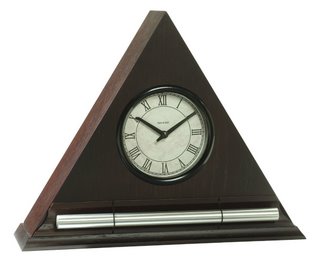 Natural Sound Alarm Clock with Chime Now & Zen’s Portable Meditation
Timer Store
1638 Pearl Street
Boulder, CO 80302
(800) 779-6383
Posted in Hot Springs, intention, Meditation Timers, Meditation Tools, mindfulness practice, Well-being
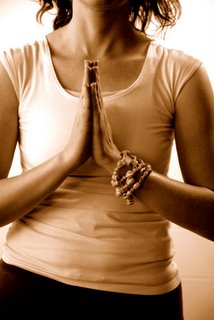 wellbeing The longer you sit at your desk, the more your posture resembles the curved, compressed arch of a camel’s hump — and the more uncomfortable you feel. Your back stands to suffer long-term misalignment as a result of slumping, while the resulting impaired breathing can lead to chronic muscle tension and drag your energy level down.
With its emphasis on core strength and alignment, Pilates counters these stresses by helping you look — and feel — a little taller. “This particular fitness discipline aims to create stability and freedom through the entire body by targeting the muscle groups that support the spine,” says New York City-based fitness and Pilates instructor James Darling. That includes the muscles deep within the back, abdomen, and pelvis. By focusing equally on strengthening and lengthening, the following Pilates favorites will foster a buoyant support system for your spine, bringing deeper breathing, more energy, and posture that’s both graceful and effortless.
Spine Stretch Forward
What It Does
Creates space between the vertebrae, lengthens the muscles of the back, and reduces lower back pain. Counteracts stress by calming the nervous system.
How to Do It
Sit on the floor with legs straight and spine tall. Drop your chin into your chest and contract your core, as if you’re trying to curl your torso up and over a beach ball. Focus on drawing your center in as opposed to curving your spine. Rest your hands where they fall, and breathe here for 30 seconds to a minute, use your Zen Timer to repeast the process with the “repeat mode”. Slowly roll back up to the starting position. Repeat six times.
adapted from Body + Soul, October 2008
Use our unique “Zen Clock” which functions as a Yoga Timer. It features a long-resonating acoustic chime that brings your meditation or yoga session to a gradual close, preserving the environment of stillness while also acting as an effective time signal. Our Yoga Timer & Clock can be programmed to chime at the end of the meditation or yoga session or periodically throughout the session as a kind of sonic yantra. The beauty and functionality of the Zen Clock/Timer makes it a meditation tool that can actually help you “make time” for meditation in your life. Bring yourself back to balance.
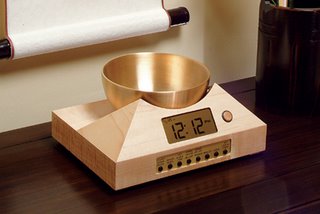 Bowl Gong Timer and Alarm Clock for a Gentle Wake UP Now & Zen’s Yoga Timer Store
1638 Pearl Street
Boulder, CO 80302
(800) 779-6383
Posted in intention, Meditation Timers, Meditation Tools, mindfulness practice, Walking Meditation, Well-being, Zen Timers
 create a sacred place to be mindful Is there a place in your home or yard where you can let go, relax, and renew your awareness of transcendent, loving oneness? It doesn’t take much to create such a place.
Your can create your healing retreat —a garden, a teahouse, a room—or you can claim one that already exists—a window seat, a rock by a stream. Your haven can be a balcony with potted plants and a wind chime, a hot tub surrounded by lavender, a bedroom where you have banished all distractions, or a comforter you roll up in like a cocoon. It needn’t even be a particular place; it can be an experience you recreate each time you need it, like a candlelight bubble bath with fresh flowers and Mozart.
There are no rules about how to create a personal haven, but consider incorporating some of these features (let your heart and your gut guide you):
• A gateway or marked entry to set it aside as sacred
• Privacy (freedom from interruptions and demands)
• A place to rest (a bed, hammock, comfortable stool)
• Calming colors
• Curved shapes
• Soft textures
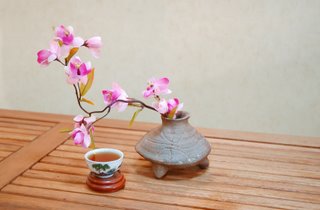 create a sacred space in your house • Plants
• Objects of beauty
• Simplicity, absence of clutter
• Soothing sounds (birdsong, moving water, music, wind chimes)
• Sunlight or soft, warm electric light
• Pleasing scents
• The four elements: air, earth (the ground, stones), water (in a bowl, fountain, or body of water), fire (sun, candles, a fire)
• A long vista, if there’s a pleasant one available
• Symbols of calm, transcendence, love, nourishment (hearts, stars, sun, moon, angels, personal treasures)
You deserve it
If you are like most people, the hardest part isn’t finding or creating a sanctuary; it’s believing that you deserve to spend time there. We tend to be so overwhelmed with demands that time taken away from meeting them feels like time wasted. We somehow learned that doing something just because it feels good is detrimental to others. Question these assumptions.
In fact, great inspiration, beautiful works of art, and profound love arise from the experience of unstructured time. In quiet, we can hear our muses and feel our passions. Here we can dream freely and drink from the deep well of our source. The peace we find carries into all our actions and relationships. What better gift can we give the world?
Although meditation can be done in almost any context, practitioners usually employ a quiet, tranquil space, a meditation cushion or bench, and some kind of timing device to time the meditation session. Ideally, the more these accoutrements can be integrated the better. Thus, it is conducive to a satisfying meditation practice to have a timer or clock that is tranquil and beautiful. Using a kitchen timer or beeper watch is less than ideal. And it was with these considerations in mind that we designed our digital Zen Alarm Clock and practice timer. This unique “Zen Clock” features a long-resonating acoustic chime that brings the meditation session to a gradual close, preserving the environment of stillness while also acting as an effective time signal.
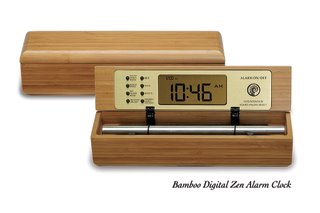 Bamboo Meditation Timers and Alarm Clocks
adapted from Natural Home Magazine, January/February2004 by Carol Venolia
 interiors that create well-being Now & Zen
1638 Pearl Street
Boulder, CO 80302
(800) 779-6383
Posted in Beauty, Chime Alarm Clocks, intention, Japanese Inspired Zen Clocks, Meditation Timers, Meditation Tools, mindfulness practice, Well-being, Zen Timers
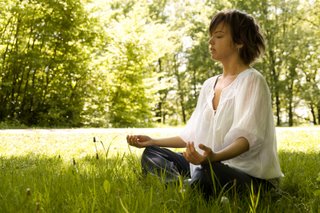 meditation guide With practice, this beginner meditation will hold the mind steady even during periods of stress.
A well-trained, stable, and focused mind is an asset in every sphere of life, and essential for any spiritual endeavor. The practice below will develop your concentration, clarity, and inner stability, by providing a single object as the resting place for your mind’s awareness—the universal mantra soham. Practice daily at about the same time, set your Meditation Timer by Now & Zen for 10 minutes, starting with 10 minutes, and gradually increasing to 20–30 minutes, or longer.
Step 1.
Begin by training your body to be still and comfortable in a sitting posture. When the spine is erect with the pelvis, chest, and head vertically aligned, the breath becomes smooth, and the mind alert and relaxed. Sit on a chair, or cross-legged on the floor with a cushion or a folded blanket under the hips. Use enough support to lift the hip joints slightly higher than the knees. This minimizes the effort needed to keep the lower back from rounding.
Step 2.
Close your eyes and mentally draw a circle of light around yourself. The circle separates you from the world of daily life—both the outer world of perceptions and activities, and the world of your familiar preoccupations and thinking patterns. With this intention, see yourself sitting inside this circle of light. It delineates a space in which you can contain your awareness; let it protect you from disturbances, distractions, and mental dissipation.
Step 3.
Feel the entire body sitting comfortably still, release any unnecessary tension, and pay attention to the movement of the breath. Refine your awareness as you feel the breath become smoother and more subtle, expanding from the solar plexus into the limbs on the inhalation, and releasing back to the solar plexus on the exhalation. Be aware of the touch of the breath everywhere in the body.
Step 4.
Making sure the body and breath stay relaxed, focus your attention at each of the following energy centers, moving systematically through the body and inhaling and exhaling once at each point: eyebrow center · throat center · right shoulder · right elbow · right wrist · each of the right fingertips, starting with the thumb · right wrist · right elbow · right shoulder · throat center · left shoulder · left elbow · left wrist · each of the left fingertips, starting with the thumb · left wrist · left elbow · left shoulder · throat center · heart center · navel center · center of the pelvis · pelvic floor · center of the pelvis · navel center · heart center · throat center · eyebrow center.
Step 5.
Now rest your attention at the eyebrow center. Feel the ebb and flow of the breath through the inner space of the whole body, while maintaining your focus on the eyebrow center. Sense the vibration of a slow wave of breath. This vibration is the mantra soham (pronounced so-hum). Hear the sound so on the inhale, and the sound ham on the exhale. The breath is subtle and slow, so let your concentration be fine and sensitive, becoming more and more one-pointed, and gradually drawing deeper into the mind. Rest in this awareness as long as you like.
To finish the practice, gradually return your awareness to the flow of the breath in the body, the physical presence of the body, and the space around you. Remain aware of the breath and your inner connection as you release the body from your sitting posture. You may want to open your eyes into the palms of your hands, massage your face, and stretch your arms and legs before getting up.
Use our unique “Zen Clock” which functions as a Yoga Timer. It features a long-resonating acoustic chime that brings your meditation or yoga session to a gradual close, preserving the environment of stillness while also acting as an effective time signal. Our Yoga Timer & Clock can be programmed to chime at the end of the meditation or yoga session or periodically throughout the session as a kind of sonic yantra. The beauty and functionality of the Zen Clock/Timer makes it a meditation tool that can actually help you “make time” for meditation in your life. Bring yourself back to balance.
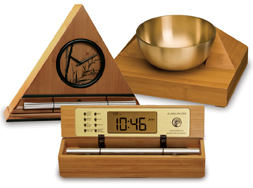 Meditation Timers with Singing Bowls & Chimes adapted from Yoga International Magazine, by Sandra Anderson
 Zen Alarm Clock, Ukiyo-e Hokusai Wave Dial Face, mediation timer and clock Now & Zen’s Meditation Timer Store
1638 Pearl Street
Boulder, CO 80302
(800) 779-6383
Posted in Chime Alarm Clocks, Meditation Timers, Meditation Tools, mindfulness practice, Now & Zen Alarm Clocks, Well-being, Zen Timepiece by Now & Zen, Zen Timers
 meditation may increase compassion Meditation might be your prescription for a happier mind and kinder heart, a new University of Wisconsin-Madison study shows. Scientists worked with 16 Tibetan monks and 16 meditation novices, giving the beginners lessons on compassion meditation two weeks prior to a series of brain-scan experiments. Those brain scans — taken while the participants responded to different emotional cues — revealed that the monks had more activity in certain brain regions involved in processing empathy. The findings, according to study authors, suggest that meditation may train the brain to increase feelings of compassion and happiness.
To start your own meditation practice, try this exercise created by “Untrain Your Parrot” author Elizabeth Hamilton:
- Set your Zen Meditation Timer with Gong for 20 minutes.
- Sitting with your spine erect, breathe deeply, placing your fingertips over the center of your chest if you like.
- As you inhale, picture a person to whom you want to extend compassion. As you exhale, silently say, “May compassion awaken.” Inhale and exhale for several breaths, focusing on the center of your chest.
- Recalling the person, silently say, “May whatever clouds compassion be healed.” Repeat this cycle with the phrase, “May this moment be experienced, exactly as it is,” and finally, “May compassion be extended to all.”
- Repeat the exercise for 20 minutes until your Zen Timer Gongs.
Use our unique “Zen Clock” which functions as a Yoga & Meditation Timer. It features a long-resonating acoustic chime that brings your meditation or yoga session to a gradual close, preserving the environment of stillness while also acting as an effective time signal. Our Yoga Timer & Clock can be programmed to chime at the end of the meditation or yoga session or periodically throughout the session as a kind of sonic yantra. The beauty and functionality of the Zen Clock/Timer makes it a meditation tool that can actually help you “make time” for meditation in your life. Bring yourself back to balance.
adapted from Body + Soul Magazine, August 2007
 Zen Timepiece, a brass singing bowl clock and timer for meditation and yoga Now & Zen – The Zen Timer Store
1638 Pearl Street
Boulder, CO 80302
(800) 779-6383
Posted in intention, Japanese Inspired Zen Clocks, Meditation Timers, Meditation Tools, mindfulness practice, Now & Zen Alarm Clocks, Well-being, zen monks, Zen Timepiece by Now & Zen, Zen Timers
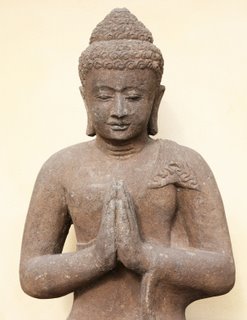 a mediation practice can be done anywhere and anytime Everybody needs a sanctuary, a place to rest and renew. The beauty of meditation — a proven and profound form of self-care for mind and body — is that almost anytime, anywhere, you can access that place of restorative calm.
Yet for some, meditation sounds mysterious or intimidating, probably because of some common misconceptions: that it’s dry or boring or “too spiritual”; that it’s an esoteric practice for those operating on some higher, more rarefied plane.
Yes, meditation is an ancient spiritual practice — one that cuts across different religions and many different traditions. But what it boils down to — however it’s practiced and whatever form it takes — is this: To meditate simply means to rest in moments of appreciative, exquisite attentiveness. Moments that allow us to savor the experience of living and that make us feel both deeply calm and deeply alert, in tune both with our self and with the world around us. Moments we come away from feeling refreshed, renewed, and engaged. Meditation is a way of communing with spirit.
 meditate under tree We all know how to meditate; it’s an instinctive ability. If you’ve ever been deliciously absorbed gazing at the flow of a river, the dance of a fire, or the twinkle of stars, you’ve enjoyed meditative moments. And you can create those moments almost anywhere at any time. If you have a favorite place in your home in which to meditate, that’s wonderful. But you can meditate just as effectively sitting at your desk or on a park bench, or lying in the grass. The fact is, the juicier and more sensual you let meditation be, the more you will get out of it.
Meditating on a daily basis is easy. Give yourself a space of time — 10 to 20 minutes morning and afternoon, or if that’s not possible, a few minutes here and there throughout the day. Set your Bamboo Zen Meditation Timer for a at least 5 minutes. Choose a pleasing, peaceful focus for attention — sensations, such as the flow of your breath; a sound you make, such as ahhh; or a visual image, such as waves coming to shore. This is your home base. Lightly focus your attention, and when your mind wanders off, gently come back to home base. Minds wander — a lot. So go easy on yourself and accept the process.
Although meditation can be done in almost any context, practitioners usually employ a quiet, tranquil space, a meditation cushion or bench, and some kind of timing device to time the meditation session. Ideally, the more these accoutrements can be integrated the better. Thus, it is conducive to a satisfying meditation practice to have a timer or clock that is tranquil and beautiful. Using a kitchen timer or beeper watch is less than ideal. And it was with these considerations in mind that we designed our digital Zen Alarm Clock and practice timer. This unique “Zen Clock” features a long-resonating acoustic chime that brings the meditation session to a gradual close, preserving the environment of stillness while also acting as an effective time signal.
adapted from Body + Soul Magazine, June 2005 by Lorin Roche and Camille Maurine
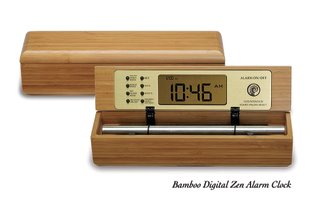 Bamboo yoga and meditation timer, designed especially for meditation practitioners Now & Zen’s Chime Timer and Alarm Clock Store
1638 Pearl Street
Boulder, CO 80302
(800) 779-6383
Posted in intention, Meditation Timers, Meditation Tools, mindfulness practice, Now & Zen Alarm Clocks, Well-being, Zen Timers
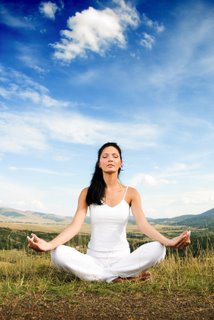 meditation practice can be done anywhere and anytime Meditation: Heart Warming
Time: 5 to 20 minutes.
When and Where: Anytime, although the end of the day is nice. Try to find a cozy place.
Position: Set your Zen Timer to 5 to 20 minutes. Sitting comfortably or lying down, eyes open or closed.
Intention: I am awake to love. I am ready to give and receive.
In this meditation you give yourself time to feel the emotional impact of all that is in your heart. Be leisurely, and linger in any of the meditation’s phases for as long as you like.
1. Begin by thinking of someone or something you love without reservation. Notice the sensations that arise in your heart and let yourself be with whatever is there — warmth, aching, joy, longing.
2. Bring both hands to your heart, feeling the warm contact of your palms against your chest. Imagine your heart being warmed by your love, melting any cold places, any part of you that is afraid, grieving, or lonely.
3. Make a humming sound, such as ahhh or ohhmm. Enjoy the way the sound vibrates in your chest for as long as you like. Then gradually let the sound fade away; you can return to it at any time.
4. Again notice the contact of your hands on your heart. Slowly open your arms outward, as you would to embrace someone. Take a few breaths and then slowly bring your hands back to your chest. Repeat this movement several times with great leisure. The simple motion of opening to give and drawing in to receive is a yoga of the heart, a way of expressing balance. End by bringing your hands back to your heart; pause, savoring the sensations and feelings.
Benefits of Meditation
– Promotes relaxation
– Enhances health
– Cultivates vitality
– Fosters clarity
– Increases focus
– Reduces stress
Use our unique “Zen Clock” which functions as a Yoga & Meditation Timer. It features a long-resonating acoustic chime that brings your meditation or yoga session to a gradual close, preserving the environment of stillness while also acting as an effective time signal. Our Yoga Timer & Clock can be programmed to chime at the end of the meditation or yoga session or periodically throughout the session as a kind of sonic yantra. The beauty and functionality of the Zen Clock/Timer makes it a meditation tool that can actually help you “make time” for meditation in your life. Bring yourself back to balance.
adapted from Body + Soul Magazine, June 2005 by Lorin Roche and Camille Maurine
 Japanese Maple Leaves Dial Face, the Zen Alarm Clock and Timer Now & Zen- Meditation Timer & Alarm Clock Store
1638 Pearl Street
Boulder, CO 80302
(800) 779-6383
Posted in Bamboo Chime Clocks, intention, Meditation Timers, Meditation Tools, mindfulness practice, Now & Zen Alarm Clocks, Zen Timers
 Toyokuni Utagawa, Flower Arrangement By skillfully managing your attention, you’re able to both experience life in a balanced way and stay oriented in a positive, productive direction. John Milton might have been thinking of the power of focus when he wrote: “The mind is its own place, and in itself / Can make a heav’n of hell, a hell of heav’n.”
Like consciousness or mind, attention is a complex neurological and behavioral business. There’s no tidy “attention center” in the brain. Instead, an ensemble of alerting, orienting, and executive networks collaborate to attune you to what’s going on in your inner or outer world in a coherent way that points you toward an appropriate response.
Along with performing the Apollonian task of organizing your world, attention enables you to have the kind of Dionysian experience beautifully described by the old-fashioned term rapt—completely absorbed, engrossed, fascinated, perhaps even “carried away”—that underlies life’s deepest pleasures, from the scholar’s study to the carpenter’s craft to the lover’s obsession. Some individuals slip into it more readily, but research shows that with some reflection, experimentation, and practice, all of us can cultivate this profoundly attentive state and experience it more often.
Considering attention’s importance, it’s surprising that until recently, science has come up with few strategies to improve it. Most new strategies have a “back to the future” quality derived from their origin in meditation, secularized and made amenable to scientific study. These cognitive regimens can strengthen attention and are both free and safe, all of which must appeal to the 78 million baby boomers and their aging children, who are equally concerned about maintaining their mental and physical health.
 Bamboo Alarm Clocks & Meditation Timers Deciding what to pay attention to for this hour, day, week, or year, much less a lifetime, is a peculiarly human predicament, and your quality of life largely depends on how you handle it. Moses got his focus from God; Picasso from his nearly supernatural creativity. We have other motivations and gifts, and most of us have to go through a more complicated process to find the right things to focus on. We must resist the temptation to drift along, reacting to whatever happens to us next, and deliberately select targets, from activities to relationships, that are worthy of our finite supplies of time and attention.
Perhaps the most important thing I’ve learned is that it shouldn’t take a crisis to show you that your life is the sum total of what you focus on or to make you question that your well-being depends on what happens to happen to you. After running that tough experiment, however, I have a plan for the rest of my life. I’ll choose my targets with care—writing a book or making a stew, visiting a friend or looking out a window—then give them my rapt attention. In short, I’ll live the focused life, because it’s the best kind there is.
Excerpted from Utne Reader, March/April 2010 from the book Rapt: Attention and the Focused Life by Winifred Gallagher
Although meditation can be done in almost any context, practitioners usually employ a quiet, tranquil space, a meditation cushion or bench, and some kind of timing device to time the meditation session. Ideally, the more these accoutrements can be integrated the better. Thus, it is conducive to a satisfying meditation practice to have a timer or clock that is tranquil and beautiful. Using a kitchen timer or beeper watch is less than ideal. And it was with these considerations in mind that we designed our digital Zen Alarm Clock and practice timer. This unique “Zen Clock” features a long-resonating acoustic chime that brings the meditation session to a gradual close, preserving the environment of stillness while also acting as an effective time signal.
 Zen Alarm Clocks with Chimes & Singing Bowls Now & Zen’s Chime Timer and Alarm Clock Store
1638 Pearl Street
Boulder, CO 80302
(800) 779-6383
Posted in Chime Alarm Clocks, Japanese Inspired Zen Clocks, Meditation Timers, Meditation Tools, Natural Awakening, Now & Zen Alarm Clocks
 yoga To find a yoga style that jibes with you, first consider whether your intentions are mainly physical, emotional, or spiritual, says Hansa, president of Yoga Alliance, an organization that registers yoga teachers nationwide. (She uses only one name.) Some people practice yoga for strength and flexibility, some crave relaxation, and some seek a connection with a higher power. (Some want all four.) There is no right or wrong reason to practice yoga, but different styles fulfill different needs. Just as if you were placing a personals ad, you need to think about what you want before you get started.
class consciousness
Yoga’s popularity has exploded of late—18 million Americans now regularly twist themselves into pretzels, more than double the number in 1997. But the sheer variety of classes to choose from can be daunting. Here’s a primer to help you decide what’s right for you.
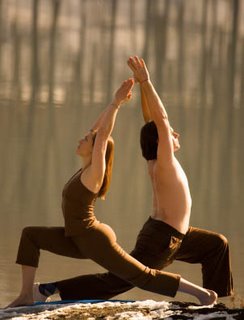 partner yoga ananda
founder: Swami Kriyananda
What it is: A gentle approach to postures, ananda yoga emphasizes calming the mind in preparation for meditation. Holding the postures is said to create self-awareness, and affirmations are often incorporated to enhance the poses.
Sign on if: You’re looking for a deeply spiritual experience that also builds strength and balance.
For more information: www.expandinglight.org
ashtanga
founder: K. Pattabhi Jois
What it is: The foundation of many “power yoga” or “power flow” classes, this fast-moving series of breath work and sweat-inducing poses is said to purify the mind and body. The room isn’t heated, but you’ll sweat anyway.
Sign on if: You like pushing your muscles to the max and conquering new heights of cardio endurance.
For more information: www.ayri.org
anusara
founder: John Friend
What it is: A dual focus on principles of alignment and physical expressiveness gives practitioners an in-depth understanding of the poses as well as a strong dose of spirituality. Although physically challenging, the style emphasizes accepting each student’s abilities.
Sign on if: You seek a physical and spiritual workout and are internally driven.
For more information: www.anusara.com
bikram
founder: Bikram Choudhury
What it is: Known as “yoga to the stars” because of its popularity in Hollywood, Bikram consists of a 90-minute series of 26 poses. Ideally, classrooms are heated to 105 degrees with 60 percent humidity to facilitate stretching and loosening of muscles and tendons.
Sign on if: You have a high tolerance for heat and respond well to a highly charged, athletic environment.
For more information: www.bikramyoga.com
iyengar
founder: B.K.S. Iyengar
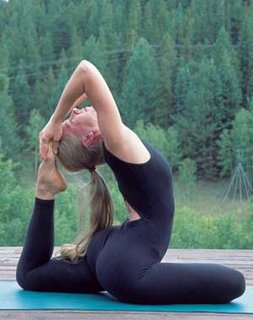 yoga What it is: Precision, alignment, and symmetry are key elements of an Iyengar class. Postures are held up to five minutes to build strength and encourage deep release. Props, such as blocks, belts, and blankets, help students hold difficult poses, but can also create a start-and-stop pace that some people don’t like.
Sign on if: You’re a detail-oriented person who likes to get things right, no matter how long it takes.
For more information: www.bksiyengar.com
kripalu
founder: Swami Kripalvananda
What it is: Slow-paced classes focus on creating an emotionally and physically safe learning environment. Offers a strong emphasis on mind-body integration.
Sign on if: Relaxation is just as important to you as building strength and increasing flexibility.
For more information: www.kripalu.org
kundalini
founder: Sikh master Yogi Bhajan
What it is: The focus is on freeing energy by awakening kundalini, the coiled energy located at the base of the spine. Despite its sexy reputation, kundalini emphasizes breathing exercises and chanting in lieu of a more physical practice.
Sign on if: The spiritual and emotional dimensions of yoga interest you more than getting a workout.
For more information: www.3HO.org
viniyoga
founder: T.K.V. Desikachar
What it is: A gentle style that incorporates asanas, chanting, breathing practices, and meditation, Viniyoga focuses on an individual’s needs and abilities.
Sign on if: You’re looking for a supportive and nurturing environment where your limitations are taken into consideration in each asana. Especially good for people with chronic health problems.
Use our unique “Zen Clock” which functions as a Yoga Timer. It features a long-resonating acoustic chime that brings your meditation or yoga session to a gradual close, preserving the environment of stillness while also acting as an effective time signal. Our Yoga Timer & Clock can be programmed to chime at the end of the meditation or yoga session or periodically throughout the session as a kind of sonic yantra. The beauty and functionality of the Zen Clock/Timer makes it a meditation tool that can actually help you “make time” for meditation in your life. Bring yourself back to balance.
 Singing Bowl Yoga Timer excerpted from Natural Solutions, June, 2003 by Catherine Guthrie
 Meditation & Yoga Timers and Clocks Now & Zen’s Yoga Timer
and Chime Alarm Clock
Store
1638 Pearl Street
Boulder, CO 80302
Posted in Chime Alarm Clocks, Japanese Inspired Zen Clocks, Meditation Timers, Meditation Tools, Now & Zen Alarm Clocks, Yoga Timer
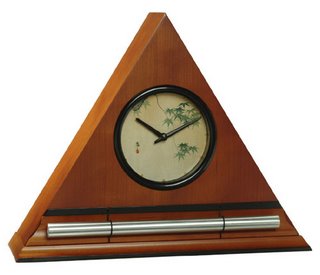 Honey Japanese Maple Leaves Zen Alarm Clock, calming alarm clock useful for remembering one's dreams Steve McIntosh is one of those spiritually driven achievers whom marketers define as part of the “cultural creatives” demographic group. He doesn’t shy away from that label; in fact, he believes that group is on the cultural frontier, making changes in their own lives that will influence our future.
It’s a movement that is going beyond materialism, but still expresses itself with certain material goods. “I want to be part of that culture. I want to express an aesthetic that would capture the mood of the time like the Tiffany lamp expressed the Art Nouveau culture prior to World War I,” McIntosh said.
The former investment banker and lawyer headed the Celestial Seasonings tea company, where, he said, he saw “how a brand can affect American culture.”
In the mid- 1990s, McIntosh was ready to set out on his own. “I wanted to create a line of consumer electronics that would use natural sounds, acoustic sounds that were housed in wood cases rather than plastic,” he said.
In 1996 in Boulder, Colo., he began his company Now & Zen, making the Zen Alarm Clock, (shown below, $119.95) a clock that emits chimes at intervals, and more recently introducing the Tibetan Phone Bell (shown above, $119) on the same principle — that sound should be beautiful and gentle.
His products “exemplify an aesthetic that combines elements of Zen, sacred geometry, classical Greece,” he said.
 zen The clock wakes the sleeper up with an initial chime, followed in 3 1/2 minutes by another, then in smaller intervals until it sounds each four seconds. That interval allows the sleeper to conclude a dream before waking, according to Now & Zen literature.
“Instead of jerking, you get this buffer between sleeping and waking that gives you your consciousness,” he said.
The Tibetan Phone Bell, which features a brass bowl from Asia, “replaces the artificial sound of a phone ringing,” McIntosh said. “Those electric sounds cause stress.”
The sounds of both products are based on an esoteric tradition that dictates what frequencies are most soothing to humans, he said.
Hardcore materialists may laugh, he said, but many people find the Zen Alarm Clock and the Phone Bell pleasant.
“You don’t have to be a Buddhist to appreciate an esthetically beautiful phone,” he said.
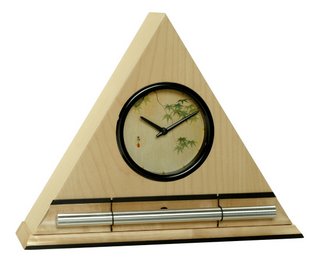 Zen Alarm Clock in Maple Finish, Japanese Leaves Dial Face, harmony in design Now & Zen products are available at the Elephant Pharmacy in Berkeley; Planet Weavers Treasure, Zen Center Book Shop, Walden’s and the Tibet Shop in San Francisco; Body Wise and Siamese Dream in San Rafael; and Milk & Honey in Sebastopol or online at www.now-zen.com.
Excerpted from San Francisco Chronicle, March 2004 by Laura Thomas
 The Zen Clock Showroom Now & Zen – The Zen Alarm Clock Store
1638 Pearl Street
Boulder, CO 80302
(800) 779-6383
Posted in Chime Alarm Clocks, Japanese Inspired Zen Clocks, Meditation Timers, Meditation Tools, mindfulness practice, Natural Awakening, Now & Zen Alarm Clocks, Progressive Awakening, Uncategorized
« Previous Page — « Previous Entries
Next Entries » — Next Page »
|
|
|
|